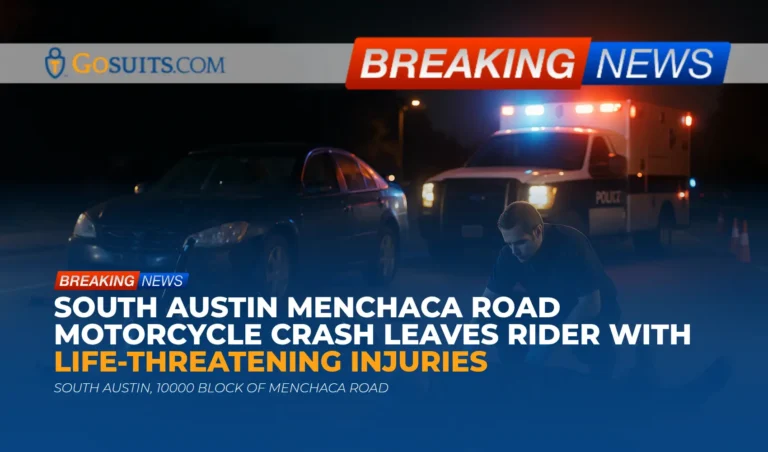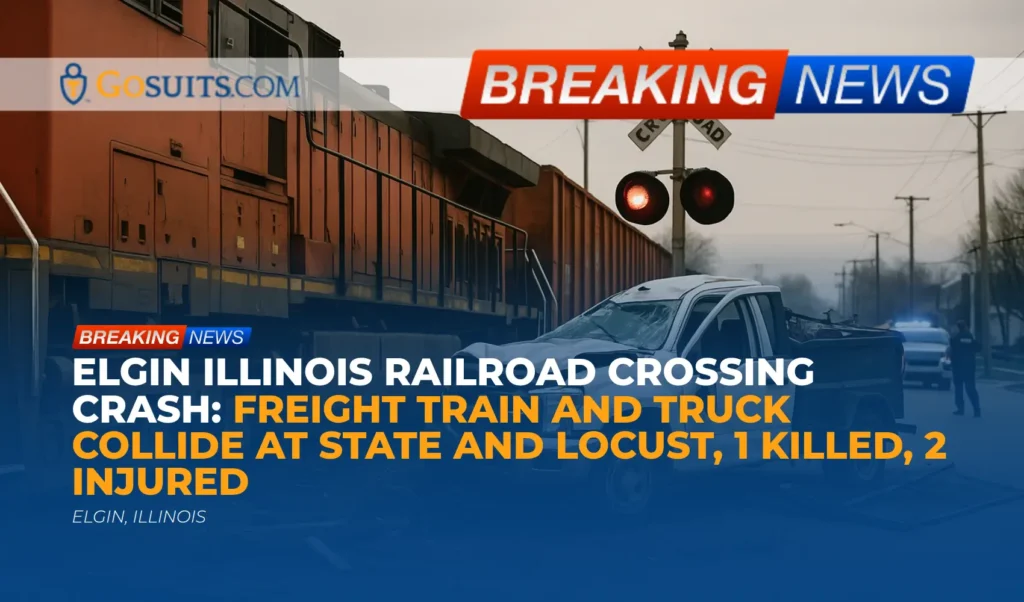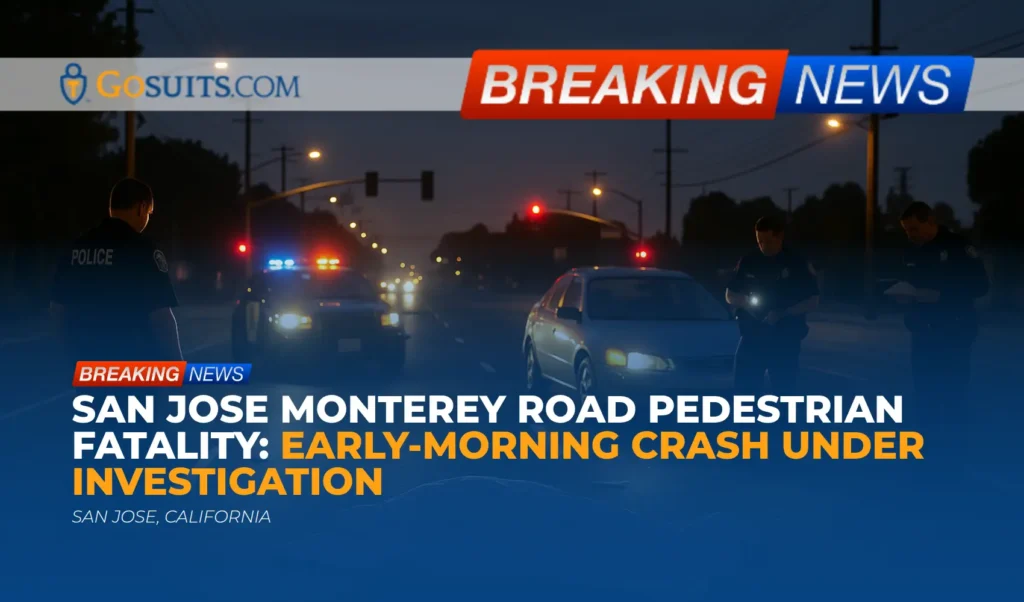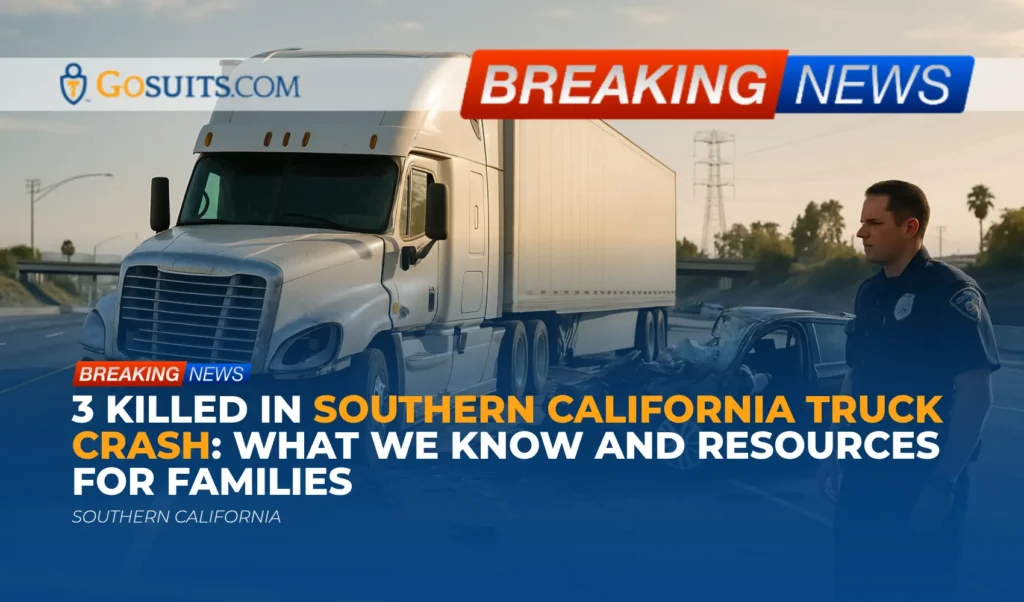- What we know about the South Austin motorcycle crash
- Location and timeline
- Initial law enforcement response and road closures
- Why motorcycle crashes are often severe
- Key rights and options for injured motorcyclists in Texas
- Evidence to secure quickly
- How to obtain official records and assistance
- Insurance and financial considerations in Texas
- Potential civil liability in a motorcycle versus vehicle crash
- Practical next steps after a severe crash
- Important time limits to know in Texas
- Data and safety context for motorcyclists
- Commentary from Gosuits Austin, Texas Personal Injury Attorney
- Why acting now matters
- Sources
What we know about the South Austin motorcycle crash
According to statements from the Austin Police Department, a motorcycle and a vehicle were involved in a crash in South Austin during the overnight hours on Sunday. The collision occurred on the 10000 block of Menchaca Road, near Redwater Drive and Old Manchaca Road, with the emergency call reported at approximately 2:30 a.m. One male was transported from the scene with injuries described as possibly life threatening. Law enforcement closed both directions of the 10000 block of Menchaca Road to investigate and later reopened the roadway around 5 a.m.
As of the time of this report, no additional details have been publicly released about the cause of the crash or the identities of those involved. The information below provides context about what typically happens after an incident like this and the kinds of civil legal and insurance issues that often arise in motorcycle collisions in Texas.
Location and timeline
The incident took place in South Austin along the 10000 block of Menchaca Road. Police reported receiving the call around 2:30 a.m., and the roadway was closed in both directions during the investigation. The road was cleared at approximately 5 a.m., allowing normal traffic to resume.
Overnight collisions often occur when visibility is reduced and when road users can be fatigued. The precise cause in this incident has not been released. Investigators typically assess factors such as lighting and road conditions, vehicle speeds, right-of-way compliance, alcohol or drug impairment, distraction, and any mechanical issues. Without official findings, it is not possible to determine fault from public reports alone.
Initial law enforcement response and road closures
When a serious injury crash is reported, Austin Police Department officers and Austin-Travis County EMS typically respond to secure the scene, provide medical aid, and preserve evidence for investigation. It is common for a roadway to be closed in both directions in the immediate aftermath of a severe crash to allow first responders to work safely and for investigators to document physical evidence like skid marks, vehicle resting positions, and debris fields.
In Texas, a reportable crash that involves injury generally leads to a Texas Peace Officer’s Crash Report, often called a CR-3. This report is filed with the Texas Department of Transportation and can be requested later by eligible parties. More details on obtaining these records are below, including links to official portals.
Why motorcycle crashes are often severe
Motorcyclists lack the protective enclosure of a car, so when a collision occurs, the rider often absorbs the energy of the impact. Even at moderate speeds, riders can experience severe trauma including head injuries, fractures, spinal injuries, internal injuries, and extensive road rash. The risk profile is not a reflection of rider fault. It is a function of exposure and the physics of collisions.
National data consistently show that motorcyclists are overrepresented in fatal and serious-injury crashes. Visibility plays a role in many crashes where another driver turns across the path of a motorcyclist or changes lanes without detecting the rider. While Texas law requires all road users to obey lane discipline and exercise ordinary care, drivers may not always correctly judge a motorcycle’s speed or distance. This is one reason why careful documentation and a thorough investigation matter in determining the actual sequence of events and responsibility.
Key rights and options for injured motorcyclists in Texas
Texas civil law provides a pathway for injured people to seek compensation from those whose negligence caused their injuries. While every case is fact-specific, several general points often apply in motorcycle versus vehicle collisions:
- Right to seek compensation if another party was negligent. If a driver failed to yield, made an unsafe lane change, or otherwise breached a duty of care that caused harm, the injured rider may seek compensation for medical expenses, lost income, pain and suffering, and other damages recognized by Texas law. The Texas Transportation Code outlines general roadway duties, including maintaining a single lane and only changing lanes when it is safe to do so. See the state’s rules on lane use and following distance for context (Transportation Code 545.060, 545.062).
- Comparative fault rules. Texas uses proportionate responsibility. An injured person’s recovery can be reduced by their percentage of responsibility and is barred only if they are more than 50 percent at fault. This is codified in the Texas Civil Practice and Remedies Code (Chapter 33).
- Two-year general limitation for injury claims. Most negligence claims for personal injury in Texas must be brought within two years of the incident, subject to exceptions. See Civil Practice and Remedies Code 16.003. It is important to confirm the deadline that applies to a specific situation.
The above is general legal context and not specific advice about any person’s situation. Facts matter. Early consultation with a seasoned attorney can help clarify options and protect rights.
Evidence to secure quickly
Evidence degrades rapidly after a crash. Traffic camera footage may overwrite within days, businesses may recycle video storage, and physical evidence at the scene can be lost once traffic resumes. Steps that can help preserve facts for the investigation include:
- Official reports and records. Obtain the Texas Peace Officer’s Crash Report (CR-3) from the Texas Department of Transportation’s system when it becomes available, and request any supplemental diagrams or photographs that the agency can release.
- Scene and vehicle documentation. Photograph the crash location, roadway markings, debris, damage to the motorcycle and the other vehicle, and any visible injuries. If vehicles are towed, photograph them before repairs.
- Witness information. Gather names and contact details of witnesses. Independent observations can be crucial where visibility or path-of-travel disputes arise.
- Video sources. Identify nearby businesses, residential doorbell cameras, and any city traffic cameras that may have captured the collision or moments prior. Request preservation promptly, since many systems overwrite within days.
- Medical records and recovery timeline. Keep records of emergency care, imaging, surgeries, medications, and rehabilitation. Track missed work and out-of-pocket expenses. Under federal rules, patients generally have the right to obtain copies of their own medical records. See the U.S. Department of Health and Human Services guidance linked below.
- Insurance communications. Save all letters, emails, and messages from insurers. Before giving any recorded statements or signing medical authorizations, consider speaking with a lawyer so you understand the implications. What is shared with an insurer can later affect a claim.
How to obtain official records and assistance
For incidents within Austin, several official channels provide records and support. The links below go to government sources:
- Texas Peace Officer’s Crash Report (CR-3). The CR-3 is filed with the Texas Department of Transportation. Eligible requestors can obtain the report through TxDOT’s Crash Records system. Start at TxDOT’s crash reports and records resource page or use the Crash Records Information System purchase portal once the report is available.
- Austin Police Department records and victim services. APD provides access to public information requests and victim services.
- Austin-Travis County EMS records. If transported or treated by Austin-Travis County EMS, individuals may request EMS patient care records using the City of Austin process.
- Medical Examiner/Autopsy records, if a fatality occurs. This incident involved serious injury, and there is no public indication of a fatality. In events that do involve a death, the Travis County Medical Examiner handles medicolegal death investigations and maintains autopsy and investigation reports per applicable rules.
- Personal medical records. Individuals have a federal right to access their health information from covered health providers.
When requesting records, note that agencies often require specific identifiers such as the crash date, location, involved vehicle information, or a service number. Reports may not be available immediately and often post after the investigating officer finalizes the submission.

Insurance and financial considerations in Texas
Multiple insurance coverages can be relevant after a motorcycle collision. The availability and limits of coverage significantly influence how medical care and other losses are addressed. Consider the following:
- Third-party liability coverage. If another driver is at fault, their liability coverage may address bodily injury and property damage claims up to policy limits. Establishing fault requires evidence and often the official crash report, along with independent investigation.
- Uninsured and underinsured motorist coverage. Texas insurers must offer uninsured and underinsured motorist coverage, which can protect injured people when the at-fault driver has no insurance or insufficient limits. Policyholders can reject this coverage only in writing. See Texas Insurance Code 1952.101.
- Personal Injury Protection, if applicable. Texas insurers must offer Personal Injury Protection coverage, which can help with medical costs and certain lost income regardless of fault, unless rejected in writing. See Texas Insurance Code 1952.151.
- Recorded statements and broad medical authorizations. Insurers often request recorded statements early. Statements can be used to challenge liability or damages later. Before speaking with any insurer or signing authorizations, consider consulting a lawyer to understand rights and potential effects on a claim.
- Property damage and diminished value. When a motorcycle is repaired after a crash, it can lose market value due to its collision history. A diminished value claim may be available depending on facts and coverage.
Insurance claims are complex. Policy language and Texas statutes govern what is available and how it is accessed. A careful review helps align expectations and strategy with the realities of coverage.
Potential civil liability in a motorcycle versus vehicle crash
Liability turns on the facts. In a collision between a motorcycle and a vehicle, investigators often examine:
- Right-of-way and lane usage. Whether turning, merging, or lane changing was done when safe, and whether any party failed to yield. Texas roadway rules require drivers to stay within a single lane and not move from that lane unless the movement can be made safely. See Transportation Code 545.060.
- Following distance and speed. Rear-end collisions with motorcycles can be severe. Texas law requires drivers to maintain an assured clear distance between vehicles. See Transportation Code 545.062.
- Visibility and lookout. Whether a driver failed to keep a proper lookout for smaller vehicles like motorcycles. Though not a single statute, this is a core element of roadway safety reflected in the Transportation Code’s safe operation rules.
- Motorcycle operating principles. Motorcyclists are entitled to full use of a lane, and two motorcycles can ride side by side in a single lane in many settings. The Texas Department of Public Safety provides official guidance for motorcycle operation and licensing, reinforcing safe lane use principles for riders and drivers alike. See the DPS motorcycle licensing resource linked below.
- Potential roadway factors. Potholes, loose gravel, or poor lighting can contribute to a crash. In limited circumstances, claims may involve roadway maintenance issues. These cases are specialized due to sovereign immunity rules and notice requirements.
It is important not to assume fault based on vehicle type. While some may speculate that motorcyclists ride at higher speeds, each case must be evaluated on its own evidence. The proportionate responsibility statute controls how fault is allocated among all involved parties, including any vehicle owner or employer if a commercial vehicle is involved.
Practical next steps after a severe crash
After a serious injury crash, immediate health and safety come first. Once stable, there are practical steps that can help protect a person’s rights and ability to pursue a claim if warranted:
- Prioritize medical care and follow-ups. Complete recommended diagnostics and treatment plans. Gaps in care are often contested by insurers. Keep all discharge instructions and follow-up referrals.
- Request official records. Obtain the CR-3 crash report when available through TxDOT, and request EMS records through the City of Austin portal if applicable.
- Preserve evidence. Save helmet and gear, damaged parts, and any aftermarket components. Do not discard items, since they can demonstrate the severity and mechanics of the impact.
- Document the recovery. Maintain a simple journal of symptoms, pain levels, sleep disturbances, and limitations in daily activities, along with missed work and any accommodations required.
- Be cautious with insurers. Before contacting any insurance company about fault or injuries, consider consulting an attorney. Statements made in early calls can be used later to dispute causation or damages.
- Consider a preservation letter. A written request that potentially relevant evidence be preserved can be sent to involved parties and nearby businesses with possible video footage. This can help ensure that valuable evidence is not deleted or overwritten.
Important time limits to know in Texas
- Two-year limitations period. In most negligence cases, the Texas Civil Practice and Remedies Code provides a two-year period from the date of injury to file a civil claim, subject to exceptions. See Section 16.003.
- Governmental entity claims. If a government entity is potentially involved, formal notice requirements and shorter timelines can apply. The deadlines and content of notice vary by jurisdiction and statute. Confirm these as soon as possible if the facts suggest governmental involvement.
- Insurance claim deadlines. Insurance policies include prompt notice provisions. Failure to notify timely can affect coverage. Review policy language and seek guidance before making statements that could limit recovery.
Because deadlines and notice rules can be complex, timely consultation with a qualified attorney is often helpful to avoid inadvertent waiver of rights.
Data and safety context for motorcyclists
National and state transportation agencies have consistently highlighted motorcyclist vulnerability in mixed traffic. The National Highway Traffic Safety Administration emphasizes that motorcyclists are at a heightened risk of severe injury and death relative to occupants of enclosed vehicles. Drivers are encouraged to check blind spots carefully, look twice at intersections, and be mindful that a motorcycle’s smaller profile can make speed and distance harder to gauge. NHTSA’s motorcycle safety resources urge both drivers and riders to use strategies that enhance conspicuity and reduce conflict points, such as proper lane positioning and scanning. A link to NHTSA’s resource page is provided below.
In Texas, the Department of Public Safety administers motorcycle licensing and education. DPS materials reinforce that motorcyclists are entitled to a full lane and that lane discipline, visibility, and hazard anticipation are crucial. They also provide guidance for drivers in sharing the road with motorcycles. The DPS and TxDOT resources cited below can help the public understand basic operational rules and safety practices without speculating about any specific incident.
Commentary from Gosuits Austin, Texas Personal Injury Attorney
Our thoughts are with the injured rider and all those affected by this South Austin crash. Collisions like this are traumatic and can disrupt health, work, and family life in an instant. This article is intended for educational purposes and general information to help community members understand what typically happens after a serious crash and what records and rights may be relevant.
Based on the limited details publicly available, investigators will be focused on reconstructing movements of both vehicles, lighting and visibility at the time of the crash, and whether any traffic control or right-of-way rules were implicated. Because motorcycles are smaller and less visible, even a brief lapse in lookout by another driver can have serious consequences. It is critical that the investigation be thorough, and that all potential video and witness evidence be identified quickly.
Insurance carriers and corporate defendants often act promptly to minimize their financial exposure. Adjusters may request recorded statements right away or ask for broad medical authorizations. Without context, people may inadvertently say things that are later used to challenge causation or to argue that care was unnecessary or unrelated. It is common, for example, for an insurer to point to a treatment gap or a preexisting condition to discount a claim. Early guidance helps avoid those pitfalls.
A free consultation with a skilled personal injury attorney can help someone understand how Texas comparative fault rules apply, what insurance coverages might be in play, and how to preserve the evidence needed to support a claim. Speaking with counsel before engaging with insurers can prevent avoidable missteps. While no one can guarantee results, informed decisions early in the process can make a real difference in protecting rights and access to care.

Why acting now matters
- Preserve time sensitive evidence. Camera systems often overwrite within days, and tire marks or debris at the scene disappear quickly. Acting promptly to identify and preserve video, photographs, and witness statements can significantly strengthen a future claim.
- Secure official records early. Crash reports, EMS run sheets, and medical records take time to obtain. Starting the request process as soon as possible ensures there is no delay when these documents are needed for treatment coordination or claims handling.
- Avoid insurance pitfalls. Insurers may seek recorded statements or broad medical releases soon after a crash. Before any such communications, it is generally wise to get a free legal consultation to understand rights and risks. Statements can be used later to challenge fault or damages.
- Protect against missed deadlines. Texas law sets strict timelines for bringing claims, and special notice rules may apply when public entities are involved. Early attention helps prevent accidental waiver of rights.
- Coordinate care and recovery. Clear documentation of medical care, time away from work, and daily limitations allows a more accurate accounting of losses and needs over time. Starting this process now makes future steps more manageable.
Sources
- TxDOT Crash Report Purchase System
- Texas Department of Transportation
- City of Austin Open Records
- Austin Police Department Victim Services
- Austin-Travis County EMS Records Requests
- Travis County Medical Examiner’s Office
- U.S. Department of Health and Human Services Right of Access
- Texas Civil Practice and Remedies Code 16.003
- Texas Civil Practice and Remedies Code Chapter 33
- Texas Insurance Code 1952.101
- Texas Insurance Code 1952.151
- Texas Transportation Code 545.060
- Texas Transportation Code 545.062
- National Highway Traffic Safety Administration Motorcycle Safety
- Texas Department of Public Safety Motorcycle License and Resources






